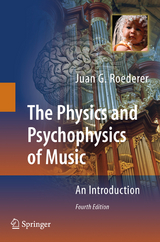
The Physics and Psychophysics of Music
Springer-Verlag New York Inc.
978-0-387-94298-8 (ISBN)
- Titel erscheint in neuer Auflage
- Artikel merken
An excellent and up-to-date general text on musical acoustics is that of Sundberg (1991). The purpose of the present volume is not to duplicate but to synthesize and complement existing literature.
1 Music, Physics, Psychophysics, and Neuropsychology: An Interdisciplinary Approach.- 1.1 The Intervening Physical Systems.- 1.2 Characteristic Attributes of Musical Sounds.- 1.3 The Time Element in Music.- 1.4 Physics and Psychophysics.- 1.5 Psychophysics and Neuropsychology.- 1.6 What is Music?.- 2 Sound Vibrations, Pure Tones, and the Perception of Pitch.- 2.1 Motion and Vibration.- 2.2 Simple Harmonic Motion.- 2.3 Acoustical Vibrations and Pure Tone Sensations.- 2.4 Superposition of Pure Tones: First Order Beats and the Critical Band.- 2.5 Other First Order Effects: Combination Tones and Aural Harmonics.- 2.6 Second Order Effects: Beats of Mistuned Consonances.- 2.7 Fundamental Tracking.- 2.8 Auditory Coding in the Peripheral Nervous System.- 2.9 Subjective Pitch and the Role of the Central Nervous System.- 3 Sound Waves, Acoustical Energy, and the Perception of Loudness.- 3.1 Elastic Waves, Force, Energy, and Power.- 3.2 Propagation Speed, Wavelength, and Acoustical Power.- 3.3 Superposition of Waves; Standing Waves.- 3.4 Intensity, Sound Intensity Level, and Loudness.- 3.5 The Loudness Perception Mechanism and Related Processes.- 3.6 Music from the Ears: Otoacoustic Emissions and Cochlear Mechanics.- 4 Generation of Musical Sounds, Complex Tones, and the Perception of Timbre.- 4.1 Standing Waves in a String.- 4.2 Generation of Complex Standing Vibrations in String Instruments.- 4.3 Sound Vibration Spectra and Resonance.- 4.4 Standing Longitudinal Waves in an Idealized Air Column.- 4.5 Generation of Complex Standing Vibrations in Wind Instruments.- 4.6 Sound Spectra of Wind Instrument Toners.- 4.7 Trapping and Absorption of Sound Waves in a Closed Environment.- 4.8 Perception of Pitch and Timbre of Musical Tones.- 4.9 Identification of Musical Sounds.- 4.10 Cognitive Brain Processes Relevant to the Perception of Individual Tones.- 5 Superposition and Successions of Complex Tones and the Perception of Music.- 5.1 Superposition of Complex Tones.- 5.2 The Sensation of Musical Consonance and Dissonance.- 5.3 Building Musical Scales.- 5.4 The Standard Scale and the Standard of Pitch.- 5.5 Why Are There Musical Scales?.- 5.6 Cognitive and Affective Brain Processes in Music Perception: Why Do We Respond Emotionally to Music?.- 5.7 Specialization of Speech and Music Processing in the Cerebral Hemispheres.- Appendix I: Some Quantitative Aspects of the Bowing Mechanism.- Appendix II: Some Quantitative Aspects of Central Pitch Processor Models.- Appendix III: Some Remarks on Teaching Physics and Psychophysics of Music.- References.
| Verlagsort | New York, NY |
|---|---|
| Sprache | englisch |
| Maße | 159 x 241 mm |
| Gewicht | 465 g |
| Themenwelt | Naturwissenschaften ► Physik / Astronomie |
| ISBN-10 | 0-387-94298-X / 038794298X |
| ISBN-13 | 978-0-387-94298-8 / 9780387942988 |
| Zustand | Neuware |
| Informationen gemäß Produktsicherheitsverordnung (GPSR) | |
| Haben Sie eine Frage zum Produkt? |
aus dem Bereich



